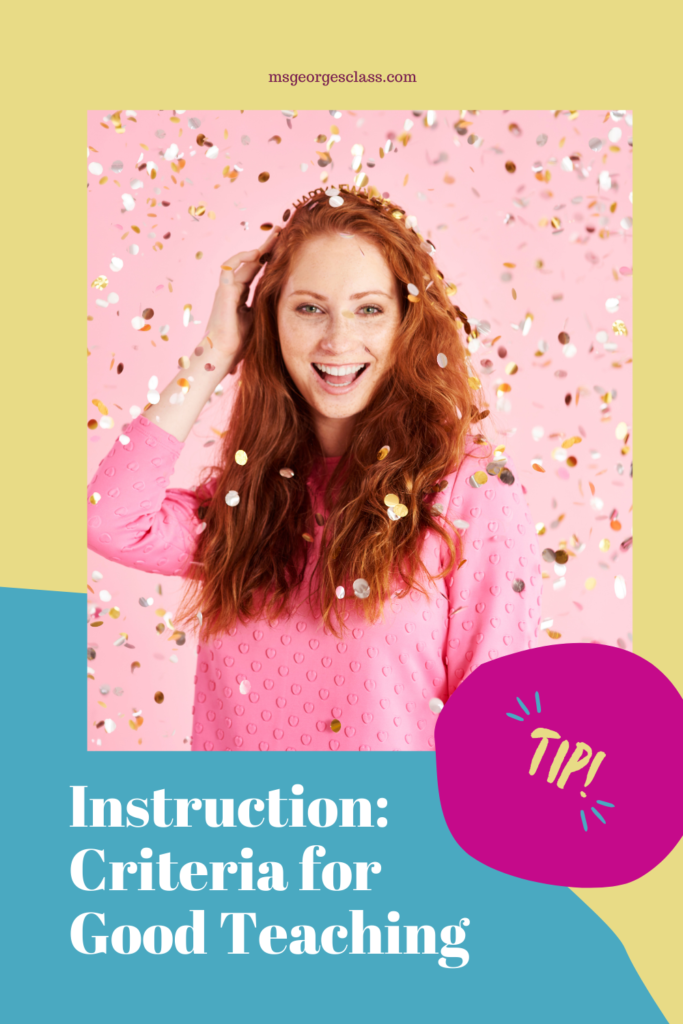This is a 7-part series. You are reading Standard 4 of the 7-part series.

Teachers take pride in their instruction. Instruction involves the action of teaching, and that includes presenting new concepts, reviewing lessons, and providing practice. As teachers, we aspire to have high expectations for all students, using strategies for the students to accomplish the lesson’s target. Providing quality instruction includes knowledge of the content standards, clear learning targets, differentiated instruction, and activities that promote and develop independent learners. When you design a lesson, you need to consider all the criteria for good teaching above. Your evaluator will observe and want evidence that you are effectively promoting a community of learners within your class. What is the focus of the lesson? What skills will the students demonstrate? Why is this learning important? Your students want to know, and you have to guide them to understand why the lesson you’re teaching is valuable to them.
Criteria for Good Teaching
According to the Standard for Ohio Standards, there are seven elements listed under Standard 4: Instruction. The elements include: 4.1 alignment of instructional goals and activities with the content standards, 4.2 use information about students’ learning to plan instruction, 4.3 communication of learning targets that are explicitly linked to lessons, 4.4 apply knowledge of how students learn and design lesson, 4.5 provide differentiate instruction to all students, 4.6 create activities that help students as independent learners, and 4.7 evidence of resources that enhance student learning. You can earn accomplish within this area if you provide artifacts and proof that you do each element within each lesson. Each lesson should be thought out and have differentiated instruction for your Special Needs, English as a Second Language, and gifted students.
Where to Begin
I have created a lesson plan that you can view here that provides brainstorming, Marzano’s nine high yielding strategies, and the “I do, We do, You do” strategy. Purchase a two-inch, three-ring binder to place your artifacts in it. The first step, you have to be familiar with the content standards and begin your lesson using one standard per lesson. One standard may last for one week, and it depends on the depth and complexity of it. Your lesson plans state the content standard and are used as evidence for this element. If you have documentation that you working on a department or Teacher Building Team (TBT), provide it, along with work you assisted on a district, regional, or state level. Next, provide proof that you used pre-assessment data that you monitor throughout the year. I have a printout of my seniors taking the district-wide assessment, Edincite, and I make notes of which question they miss. Remember, your evaluator wants evidence and demonstration of steps to create lesson plans.
Lessons include students restating learning targets and goal setting. Having students know and understand what they must accomplish to proceed improves student confidence and increases passing grades, not to mention it aligns with element 4.3. During every lesson, I state the learning target several times, and it’s posted on the board and on the assignment. Empowering students to create goals for the lesson will increase your evaluation score for the element. Teachers must understand each student’s learning processes, individual needs, and how to stimulate the learning process. Have students answer surveys that measure their readiness, learning preference, and interest. Provide notes from IEP and 504 meetings and evaluate research-based strategies that accommodate students that are on those plans.

Show Proof of Differentiation Instruction
Although I have a Master’s degree in Special Education, I had to review differentiated instruction to provide quality instruction for each student. I strongly suggest reading How to Differentiate Instruction in Mixed Ability Classrooms by Carol Ann Tomlinson. On my class list, I color-coded students that are identified as gifted, ELL, or have an IEP. When designing lessons and questioning students, I look at my list to assist me. Element 4.5 focuses on differentiated instruction, and evidence is strongly needed within this area. Use research-based methods and strategies, such as Tomlinson’s book that was mentioned, and learn about your students through surveys, samples of students’ work, written descriptions of instruction, and copies of feedback and individual learning strategies. Since we are currently doing virtual learning, I use Google Classroom to write directions, provide feedback, and provide notes such as extended time or modified grading. I print out the documents on demand for the Intervention Specialist or for a parent meeting.
When preparing lesson plans, I also create questions I am going to ask students and some questions that may arise. I look at Marzano’s Objective Taxonomy and write two questions from the analysis and knowledge utilization categories. Performing this act is part of element 4.6, developing independent learners. Use essential questions, have class debates to defend solutions, or write higher-level questions in your lesson plans to provide evidence. Element 4.7 is using resources, including technology, within your lessons. Many teachers within my building use the Remind app to help keep students on track with due dates and the resource Turnitin to check for plagiarism within essays. Currently, we are using technology daily. However, I wonder how I stand out from my co-workers. Using assessment tools such as Socrative, Formatives, or Padlet within my classes will provide variety from the usual Google Apps. Also, documenting how using the resources to meet the students’ needs helps within the evaluation process.
Evidence and Artifacts for Instruction
| Lesson Plans | Think, Pair, Share | Surveys | Journals |
| Video Clips | Exit Slips | Open-Ended Questions | K-W-L Chart |
| I do, We do, You do Model | Anchor Activities | Stating Lesson Target and Having it on Assignments | Students Teach Content |
When your evaluator enters your room, they should know that you’re giving quality instruction by your actions and learning target stated on the board. Regardless of a student’s ability, you are the professional that provides a lesson designed for each student because you took the time to create a lesson plan with each student in mind. Have a color-coded class list for easy reference when creating lessons. The goal is to have every student meet the learning target with the proper instruction to accomplish it. A teacher has to consider the whole student, including their background, past assessments, IEP, and learning preference, to create a lesson that demonstrates the skill of understanding. Instruction is the foundation of teaching, advances each individual student, and is the criteria for good teaching.
How do you prepare for your teacher evaluation? Do you provide documentation of how you provide instruction, and if you do, what artifacts do you use? State your answer below in the comment section.





Leave a Reply